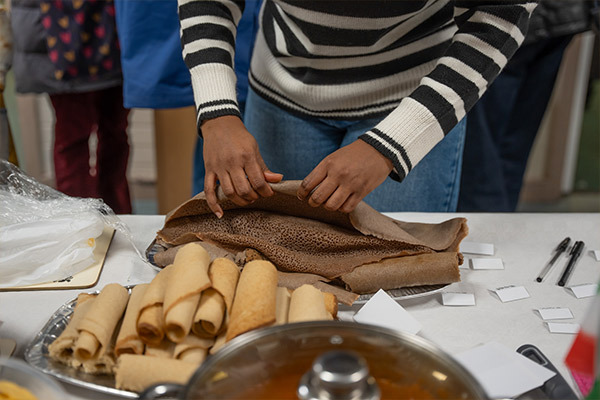Rahel's injera recipe
Injera is a spongy, sour flatbread with a consistency somewhere between a crepe and a pancake. Because injera needs to be fermented for its unique slightly sour taste, allow 3 days between making the dough and cooking it.
This recipe was written by Rahel in partnership with Heart & Parcel and Boaz for our livestreamed cookalong in 2021.
Ingredients
750g self-raising flour
375g fine cornmeal
1 tablespoon quick acting yeast
1.5L Warm water
Method
- Toast 750g of self-raising flour over a high heat in a frying pan for around 1-2 minutes, stirring constantly. Put it to one side.
- Toast 375g of fine cornmeal over a high heat in a frying pan for around 1-2 minutes, stirring constantly. Put it to one side.
- Mix the toasted flour and cornmeal together and leave it to cool for 10 minutes.
- The first time you ever make injera, put one tablespoon of instant dry yeast into warm water and mix. In a big plastic tub container with a lock tight lid, pour the flour mixture and yeast water together and start to combine with your hands.
- Add warm water through your hands and start to bring the mixture together. Knead for about 5 minutes whilst continuing to add water. It should start off like a thick bread dough and by the end it should resemble thin pancake batter.
- Secure the lid on top of the tub and store in a cool area for 3 days - not the fridge! Because this is a fermentation process, you may get some extra gas forming in the container. You can just 'burp' the container by opening it for a few moments and then closing it again.
- Then, 3 days later: open the container. The batter should have bubbles on the top and smell slightly sour. Get a cup and skim the water off the top, then pour it back in slowly while stirring the mixture gently.
- Put in a large, non-stick, lidded frying pan or sauté pan on a medium heat. Meanwhile, tip some of the injera batter into a jug ready to pour.
- When the pan is hot, pour about 100ml of the mixture into the pan (or until the bottom of your pan is completely coated) in a circular motion from the centre, spreading the mixture out to resemble a crepe. Leave for around 10 seconds, and then cover with a lid. You should start to see tiny holes forming on the surface due to the bubbles of fermentation. Wait for 1-2 minutes until the injera is cooked through, then carefully loosen the edges and peel it off with your hands (making sure you don't burn yourself) and place on a plate to cool. Repeat the process, but make sure the injera you have just made has its own plate to cool on, before going onto the pile. This should stop them getting too damp and sticking. Your mixture should make 15-18 injera, but if you want to you can keep some of the batter aside to 'feed' with more flour, like a sourdough starter, for your next meal.
- Once you have made all your injera, lay them on a serving platter and enjoy with your guests! Injera is perfect for scooping up an accompanying stew or curry.





